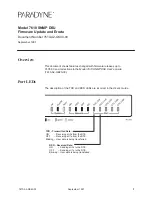
3
mselectronics.co.uk
Positioning
Figure 3 illustrates the typical detection pattern
of the PIR sensor when the unit is wall-mounted.
Ensure that the proposed mounting position will
offer the required area of detection.
High Sensitivity Zone:
Detects e.g. arm movement.
Low Sensitivity Zone:
Detects e.g. whole body movement.
Tips
•
The sensor is most sensitive to motion across
its field of view, rather than directly towards or
away from the sensor.
•
Avoid mounting the unit close to a light or heat
source (the one being switched, or otherwise)
since this may interfere with the detection.
•
Multiple units may be wired in parallel to
extend the detection field – see
Using Multiple
Detectors
.
Figure 3
PIR sensor detection pattern
Electrical Requirements
Before attempting to install the unit, ensure that the intended load and wiring arrangement
comply with the following requirements. Figure 2 shows a typical wiring example.
•
3-wire (live/n volt-free switch) connection:
The unit requires a permanent
live/neutral connection, and as such is
not
suitable for replacing an existing light switch
with no neutral conductor at the switch location. A volt-free relay output is provided,
which can be used to switch a load on the same mains supply (by connecting across
from
L
to
COM
, making
N/O
a switched ‘Live Out’), or to provide a contact closure to a
separate load or control signal. There is no minimum load requirement.
Also available:
WMPD2
/
WMPAD2
/
WMPAD2-L
(2-wire versions) – Suitable for ‘inline’
connection with the load to be switched (no neutral required), such as to replace a
standard light switch. A minimum load of
20W (per detector)
applies; a load capacitor is
required for smaller loads.
•
Maximum load:
The maximum load rating is
16A (4000W)
, however for high inrush
loads (such as most types of lighting) a lower limit applies: see
Technical Specification
.


























